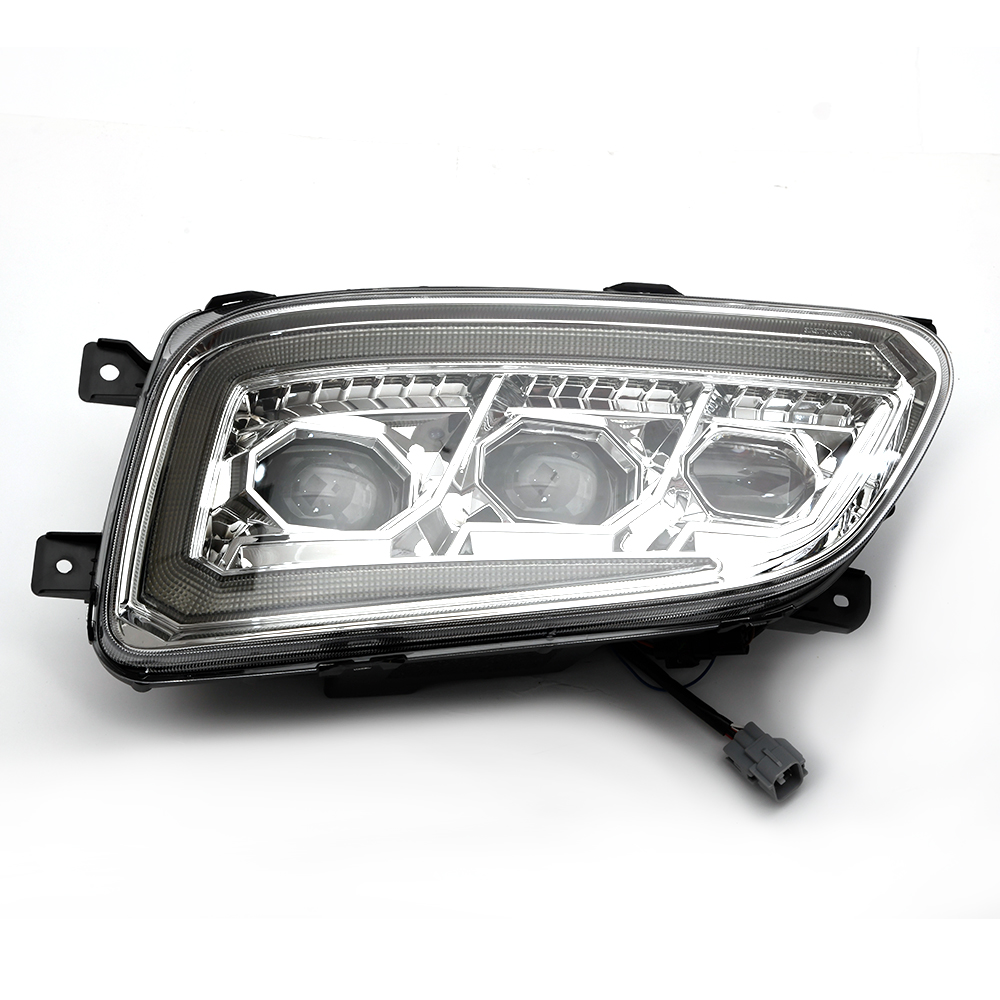IlG'or yoritish texnologiyasi bilan flot operatsiyalarini o'zgartirish
Avtomobil sohasida transport vositalarini jihozlash va ulardan foydalanishda inqilobiy o'zgarishlar sodir bo'lyapti, bu sohada LED lampalar traktorlar uchun energiya samaradorligi yechimlari yetakchi o'rin tutmoqda. Ushbu zamonaviy yoritish tizimlari flot operatorlari hamda mustaqil traktor haydovchilari tomonidan tezda standart tanlovga aylanayotgan bo'lib, energiya iste'moli, xavfsizlik va operatsion xarajatlarni kamaytirish jihatidan oldindan boshqa hech narsa taqdim etilmagan. Avtomobil sanoati barqaror texnologiyalarga ega bo'lishda davom etsa, traktorlar uchun LED lampalar tijorat transportining kelajagini qayta shakllantirayotgan transport vositalari yoritishidagi muhim yutuqdir.
LED texnologiyasining texnik ustunligini tushunish
Asosiy qism va ishlangan princip
Yuk mashinalari uchun LED lampochkalar elektr energiyasini bevosita yorug'likka aylantirish uchun ilg'or yarimo'tkazgich texnologiyasidan foydalanadi. An'anaviy galogen yoki nurlanuvchi lampalardan farqli o'laroq, LED lar yorug'lik hosil qilish uchun spirali isitishga tayanmaydi. Ushbu asosiy farq issiqlik tarqalish orqali energiya sarfini ancha kamaytiradi va ularni an'anaviy yoritish echimlariga qaraganda 80% gacha samaraliroq qiladi. LED komponentlarning qattiq holatdagi tuzilishi shuningdek, spiral va shishali korpus kabi an'anaviy lampalarda uchraydigan odatdagi nosozliklarni bartaraf etadi.
Mumkin bo'lgan eng yaxshi dizayn xususiyatlari
Yuk mashinalari uchun zamonaviy LED chiroqlar yorug'lik chiqishini maksimal darajada oshirib, quvvat iste'molini minimal darajaga tushiradigan yuqori texnologik optik dizaynlarni o'z ichiga oladi. Aniq muhandislik asosida yaratilgan linzalar va aks ettirgichlar boshqa yo'lovchilarga nurlanish yaratmasdan haydovchilarga yaxshiroq ko'rinish imkonini beradi. Ushbu murakkab dizaynlarga optimal ish haroratini saqlaydigan issiqlikni boshqarish tizimlari ham kiradi, bu esa LED komponentlarning xizmat muddatini yanada uzaytiradi.

LEDni joriy etishning iqtisodiy afzalliklari
Uzoq muddatli maddi saqlantirishlarni tahlil etish
Yuk mashinalari uchun LED chiroqlarga dastlabki sarmoya kiritish odatdagi yoritish vositalariga qaraganda yuqori bo'lishi mumkin, lekin uzoq muddatli jihatdan moliyaviy foydasi sezilarli. Ko'p hollarda 50 000 soatdan ortiq ishlash muddatiga ega bo'lgan LED birliklarning uzoq xizmat muddati almashtirish chastotasini va bilan bog'liq mehnat xarajatlarini ancha kamaytiradi. Flot operatorlari odatda LEDga sarmoya kiritgandan keyingi birinchi yil ichida o'z xarajatlarini qoplay boshlaydi va uskunalar faoliyat muddati davomida tejash saqlanib qoladi.
Texnik xizmat ko'rsatishni kamaytirish ta'siri
Yuk mashinalari uchun LED lampalarning chidamliligi bevosita texnik xizmat ko'rsatish talabini kamaytiradi. Qattiq qurilma tebranishlarga, harorat ekstremallariga va an'anaviy lampochkalarning ishdan chiqishiga olib keladigan qattiq ob-havo sharoitlariga chidamli. Bu ishonchlilik tufayli favqulodda ta'mirlash ishlari kamayadi, to'xtash vaqti qisqaradi va umumiy flot uchun texnik xizmat ko'rsatish xarajatlari pasayadi. Shuningdek, LEDlarning barqaror ishlashi noto'g'ri yoritish bilan bog'liq qimmatbaho yo'l tomoshasi va potentsial buzilishlarni oldini oladi.
Ekologik va xavfsizlik foydalaridan
Kamaytirilgan Uglerod Izlari
Yuk mashinalari uchun LED lampalarning energiya samaradorligi bevosita yoqilg'i iste'molini kamaytirishga va chiqindilarni kamaytirishga hissa qo'shadi. Barcha flot bo'ylab ko'paytirilganda, energiya iste'molini kamaytirish katta atrof-muhit foydasini olib kelishi mumkin. LED chiroqlar ishlab chiqarish jarayoni ham an'anaviy lampalarga qaraganda kamroq resurslarni talab qiladi va ularning uzoq muddat xizmat ko'rsatishi kerak bo'lgan almashtirishlar va chiqindilarni kamaytiradi, bu esa atrof-muhitga ta'sirni yanada kamaytiradi.
Ishlatish xavfsizligini oshirish
Yuk mashinalari uchun LED lampalar yorqinroq va aniqroq yoritish hamda darhol yonish imkoniyati tufayli ajoyib ko'rinuvchanlikni ta'minlaydi. Chiqariladigan yorug'lik sifati tabiiy kunduzgi yorug'likka juda yaqin bo'lib, kechasi ishlash davrida haydovchining charchashini kamaytiradi. LEDlarning tezkor reaksiya vaqti tormoz chiroqlari darhol yonishini anglatadi, bu esa orqada harakat qilayotgan transport vositalariga reaksiya berish uchun ko'proq vaqt beradi. Bu yaxshilangan xavfsizlik ko'rsatkichi flot operatorlari uchun halokatlar sonini kamaytirishga va sug'urtani arzonlashtirishga olib kelishi mumkin.
O'rnatish va Integratsiya Talablari
Professonal montaj talablari
Yuk mashinalari uchun LED lampalarni to'g'ri o'rnatish elektr uzatmasi mosligi va o'rnatish xususiyatlariga e'tibor berishni talab qiladi. Ko'plab LED tizimlari mavjud armaturalarni bevosita almashtirish uchun mo'ljallangan bo'lsa-da, mutaxassislarning o'rnatishi ishlash samaradorligini optimallashtiradi hamda qonunchilik talablarga rioya etilishini ta'minlaydi. Texniklar kuchlanish talablari, issiqlik tarqalishi hamda atrof-muhit omillariga nisbatan to'g'ri germetiklantirish kabi jihatlarni hisobga olishlari kerak.
Tizim Integratsiyasi Strategiyalari
Yuk mashinalari uchun zamonaviy LED chiroqlarni ilg'or flot boshqaruv tizimlari bilan integratsiya qilish mumkin, bu yoritish ishlashini va energiya iste'molini nazorat qilish imkonini beradi. Bu integratsiya operatorlarga yoritish tizimi holatini kuzatish, oldini olovchi texnik xizmat ko'rsatish jadvalini belgilash va flotdagi energiya iste'molini optimallashtirish imkonini beradi. Aqlli tizimlar bilan mos kelishi LED yoritishni yanada ulanuvchan va samarali tijorat transport vositalariga o'tishda asosiy komponent sifatida o'rnatadi.
Koʻpincha soʻraladigan savollar
Tijorat yuk mashinalarida LED chiroqlar odatda qancha muddat xizmat ko'rsatadi?
Yuk mashinalari uchun LED chiroqlar odatda foydalanish sharoitiga va o'rnatish siforiga qaramay, 50,000 dan 100,000 soatgacha xizmat ko'rsatadi. Bu oddiy ish sharoitida taxminan 5-10 yilga to'g'ri keladi va an'anaviy yoritish echimlarining umrini ancha orttiradi.
Flot operatorlari LED yangilanishlardan qanday energiya tejamkorligini kutishlari kerak?
Flot operatorlari odatda an'anaviy yoritish tizimlariga qaraganda 60-80% energiya tejashni boshdan kechiradi. Bu samaradorlik yoqilg'i iste'molini kamaytirish va ishlatish xarajatlarini pasaytirish bilan bog'liq bo'lib, ko'plab operatorlar faqat energiya xarajatlari bo'yicha har bir transport vositasiga yiliga yuzlab dollarni tejash haqida xabar beradi.
Yuk mashinalari uchun LED lampalar joriy qoidalar talablariga javob bermaydimi?
Sifatli yuk mashinalari uchun mo'ljallangan LED lampalar to'g'ri o'rnatilganda DOT hamda FMCSA qoidalari talablarini bajaraman yoki oshirib ketadi. Ko'plab ishlab chiqaruvchilar joriy xavfsizlik va ishlash standartlariga mos kelishini ta'minlash uchun sertifikat hujjatlari hamda sinov hisobotlarini taqdim etadi.


